rupertlssmith
Junior Member level 1
I bought 6 12V lead acid batteries, 7.0Ah. The project I want to use them for has not materialized yet so they are just sitting around my workshop. I feel like I should have them on a float charge to keep them in good condition? If this is the case, where can I buy a charger that will keep all 6 on a float charge?
